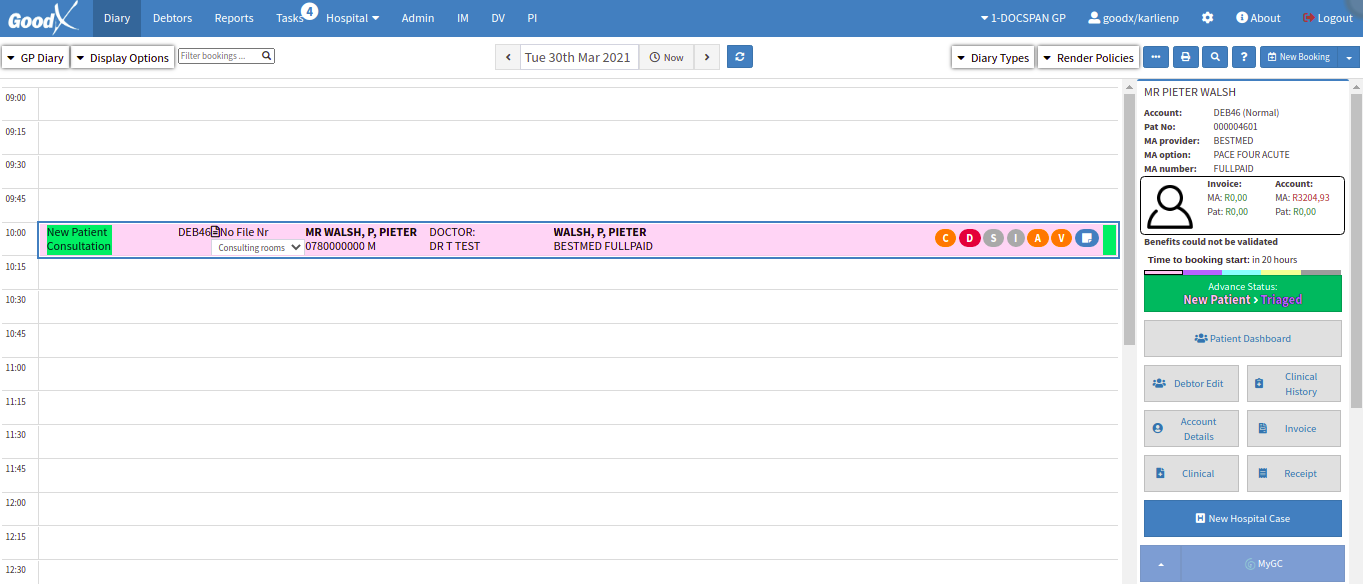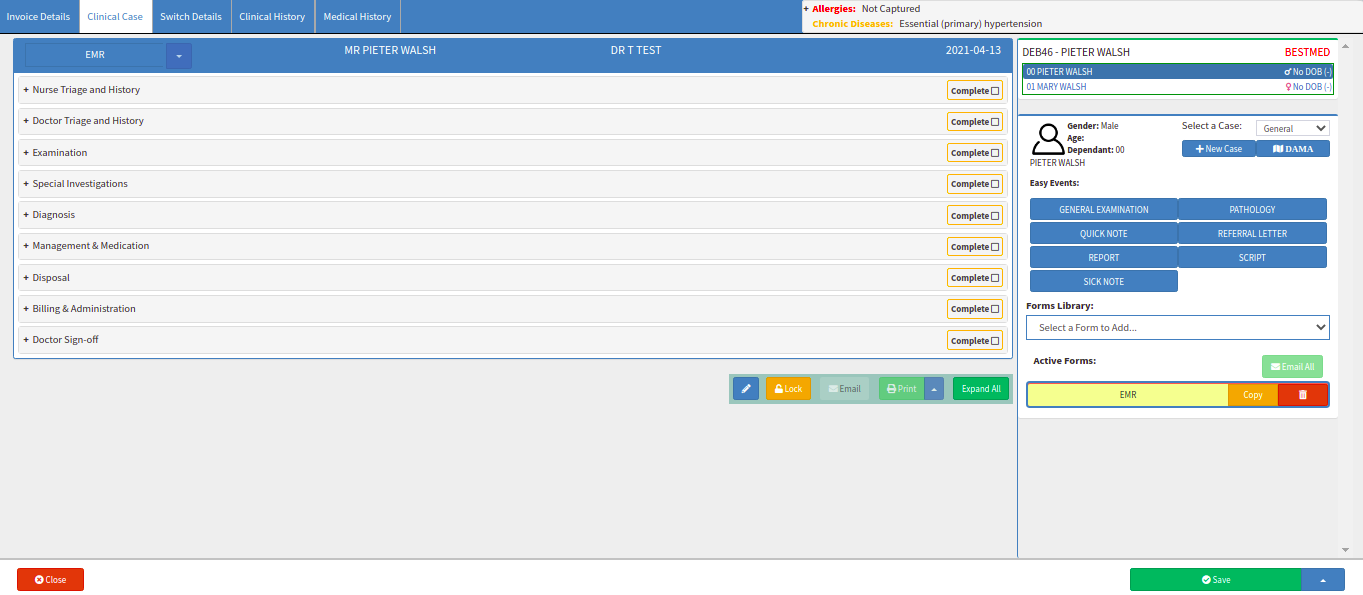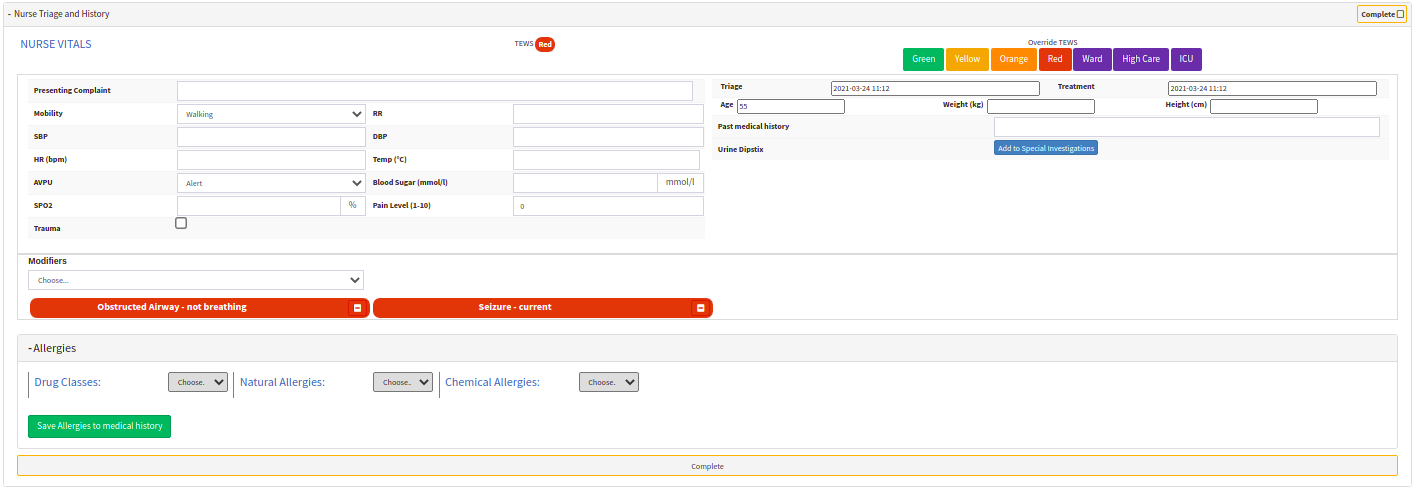EMR Form: Nurse Triage and History
The EMR Form is used to provide decision support to healthcare professionals for the rendering of healthcare services to an individual patient and accommodate data exchange in the Emergency Room.
A Triage form is a clinical form that the ER nurses use to check the patient's vitals and appearance. This form automatically changes the colour of importance regarding the information that the nurse completes.
- Log in to the GoodX WebApp using your GoodX username and password.
- From the Diary, click on the patient booking. The Sidebar will appear on the right-hand side of the screen.

- Click on the Clinical button.
![]()
- The Clinical Case screen will open.

- From the Forms Library drop-down, select the EMR form to complete.

- The EMR Form screen will open.

- Click on the Nurse Triage and History panel to expand it.
![]()
- The Nurse Triage and History screen will open when the panel is expanded.

- The Nurse and Triage History refers to the formal process of early assessment of the patients attending an accident and emergency department by a trained and qualified nurse, to ensure that they receive appropriate attention, in a suitable location, with the requisite degree of urgency. The patient's Vitals will be completed in this section.
The NURSE VITALS:
![]()
- Presenting Complaint: How the patient explained how he/she feels, this is a free text field.
![]()
- Mobility: Ability to move or be moved freely and easily. From the drop-down, you can select whether the patient is:

- Walking: The patient is able to walk by his/herself.
- With help: The patient needs someone to help with the walking.
- Immobile: The patient can't walk whatsoever. The patient is brought into the rooms / hospital in a wheelchair or similar assistance.
![]()
- SBP: Systolic Blood Pressure eg. 120/80.
![]()
- HR (bpm): The patient's heart rate, beats per minute.
![]()
- AVPU: This is to indicate whether the patient is Alerted, reacts to voices, reacts to pain, or unconscious. From the drop-down, you can select how your patient is responding:

- Confused: The patient doesn't know what is happening around him/her.
- Alert: The patient is aware of the movement.
- Reacts to voices: The patient reacts to people talking to him/her.
- Reacts to pain: The patient can feel pain when he/she is touched.
- Unresponsive: The patient is not responding or reacting to any action or question asked by the Medical staff.
![]()
- SPO2: This is Oxygen saturation, this will tell you how much oxygen the patient is carrying in their blood. A normal patient should be 96% to 99%.
- Trauma: You can tick the trauma box if the patient has any responses to pain, injury, serious illness, medical procedures and / or frightening treatment experiences.
![]()
- RR: Respiratory Rate. A person's respiratory rate is the number of breaths you take per minute. The normal respiration rate for an adult at rest is 12 to 20 breaths per minute. A respiration rate under 12 or over 25 breaths per minute while resting is considered abnormal. Complete the RR as a number in this field.
![]()
- The system will warn you if the RR is not normal by turning the field red.
![]()
- DBP: Diastolic Blood Pressure. The diastolic reading, or the bottom number, is the pressure in the arteries when the heart rests between beats. This is the time when the heart fills with blood and gets oxygen. Normal diastolic blood pressure is lower than 80. Complete the DBP as a number in this field.
![]()
- Temp (°C): The patient's temperature in celsius.
![]()
- Blood Sugar (mmol/l): Check the blood sugar rate.
![]()
- Pain Level (1-10): The level of pain that the patient is in. 1 minimum pain, 10 going to pass out.
![]()
- Triage: The system will automatically complete the triage field with the date and time the Nurse Vitals is completed by the Nurse.
![]()
- Treatment: The system will automatically complete the treatment field with the date and time the treatment is started by the Nurse.
![]()
- Age: The patient's age in years.
- Weight (kg): What does the patient weigh in Kg.
- Height (cm): The height of the patient in Cm.
![]()
- Past medical history: Previous medical conditions or treatments.
![]()
- Urine Dipstick: Click on the Add to Special Investigations button to add a urine test to that section.
- The Bedside - Urine dipstix test will be added to the Special Investigations
Section.

- The nurse will do the test and indicate the results in the blocks. The Urine dipstix will be explained in detail in the Special Investigations manual. Click on the link to open that manual.
- Override TEWS: The override TEWS automatically changes the colour of importance regarding the information that the nurse completes.
![]()
- T: Triage.
- E: Early.
- W: Warning.
- S: Score.
Please Note:
- Under the Override TEWS icons, when either Ward, High Care or ICU is set as the Override TEWS, a trigger will set
the booking type on the Diary to Ward Visit. - This trigger on the diary will only occur when this is set in the Nurse Triage History and Doctor Triage and History section. Only when the user marks the Doctor Triage and History as Completed will the trigger update the booking type to ‘Ward Visit’ on the Diary.
- The Override TEWS will always override the booking type on the Diary if it is set up correctly. Make sure that the Ward Visit Booking Type with the colour (purple #899AFF) is set up in Settings.
- For more information on How and Where to set up the booking type, please click on the Settings button at the beginning of this manual or click on the following link: Booking Type Setup. If this booking type is not set up, the trigger will not override the Diary booking type when Ward / High Care / ICU is selected on the EMR Form.
- The override TEWS automatically changes the colour of importance regarding the information that the nurse completes.
- The Green, Yellow, Orange, and Red colours are an indication of the urgency of the patient, it will automatically change as you complete the form:
![]()
- Green: The patient's vitals is normal or near-normal, the patient is not bleeding or unresponsive and can help themselves. The patient is in no medical danger and will be assisted after all the other colours of the time.
- Yellow: The patient's condition is manageable and can wait to be treated, the patient is responsive and the vital signs are not in a dangerous state.
- Orange: The patient's medical state is under emergency but is still responsive eg. A patient with really bad bleeding or have been in a bad car accident.
- Red: Urgent, the patient is in a life or death state, the patient is unresponsive or needs immediate assistance
- Modifiers: This is set up per entity, you can select from the drop-down what modifier to use.

- Click on the Allergies panel to expand the panel.
![]()
- The Allergies screen will open.

- The Patient's allergies will be completed and saved under this section for the Doctor Vitals. This will affect scripting as a warning will display should you, for example, prescribe Amoxicillin to a patient that is allergic to penicillin.
![]()
- Save allergies to Medical History button: this button will save all the allergies to the patients Medical History on their debtor for future reference. Click on the link to open the Medical History manual for a more detailed explanation.

- Click on the Complete tick box when you've completed the Nurse and Triage History Section.
- The Complete tabs will turn green to indicate the section/s is completed.

- Click on the Close button to exit the EMR screen without saving.
- Click on Save and Close to save the form or the changes made.
![]()
- Click on the Save and Close drop-up arrow for more options:

- Save: Click on the Save button to save the information captured on the Form.
- Save Lines to New Macro: Click on the Save Lines To New Macro button to save the lines captured as a Macro.
Last modified: Friday, 7 April 2023, 7:54 PM